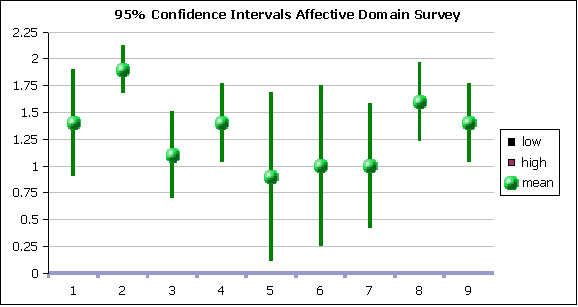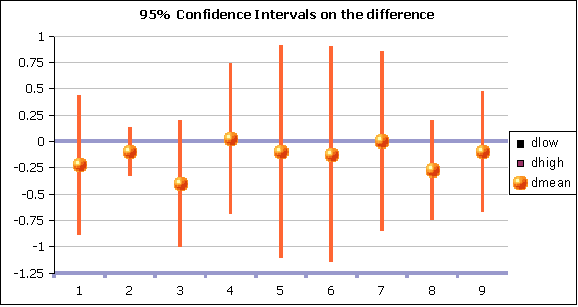
The Exercise Sport Science program has one affective domain student learning outcome:
Students will value physical activity and its contribution to a healthful lifestyle.
The PE 101j Joggling course has an affective domain student learning outcome identical to the above:
Students will value physical activity and its contribution to a healthful lifestyle.
The course also has a second student learning outcome currently listed as a course intention:
Students will have an opportunity to experience the joys of aerobic exercise: the feelings of strength, energy, and stress release.
The issue of including and evaluating affective domain outcomes was covered in a document written 13 November 2002, http://www.comfsm.fm/~dleeling/department/slorevolution_vi.html.
In December 2003 a survey was given to the joggling students. The students answered nine questions:
The students were offered the following choices: strongly disagree, disagree, maybe, agree, strongly agree. The five options were assigned the following values:
Strongly disagree: -2
Disagree: -1
Maybe: 0
Agree: 1
Strongly agree: 2
The results of the fall 2003 survey were reported on in a document at: http://www.comfsm.fm/~dleeling/department/slorevolutionviii.html
On 22 April the same survey was administered to the spring term joggling class. The results paralleled the results of last fall.
There was no statistical disagreement with any of the statements. The 95% confidence intervals were calculated for each question: any question that crosses y = 0 would be deemed statistically indistinguishable from "maybe." Although the sample size is small, the number exceeds the minimum of five for calculating a confidence interval. The chart below has the question number on the horizontal or x-axis. The ball is at the mean or average, the green bar is the extent of the 95% confidence interval.

As seen in the results of fall 2003, questions two and eight again generated the strongest agreement. The students conceive that physical fitness is important and they had fun. The answer to question two was unanimous strong agreement. The students value that which the program learning outcome indicates they are to value as a result of the program: physical activity and its contribution to a healthful lifestyle .
Questions five, six, and seven show the least agreement and largest standard deviations, with the underlying data including a number of answers of "maybe" and one "disagree." Some of the students do not feel that they are more fit and may not continue running in the future. Question six split cleanly with half the students strongly agreeing and half the students responding maybe. Given that the students might be disinclined to answer in the negative, a maybe could be construed as a negative answer.
Number nine directly asked whether the student learning outcome that was couched as a course intention was accomplished. The 1.4 average, slightly below the 1.5 of fall 2003, and a confidence interval that is wholly above 1 indicates continued moderately strong agreement. This outcome can be measured and can be reported upon, even though it was this very outcome that generated the most flak in the fall of 2002.
The means from the spring 2004 survey were at or below the means for the fall 2003 survey except for question four. Although the means had dropped, no drop was statistically significant. The largest drop of -0.4 was seen for question three, yet even this drop did not attain statistical significance.
The following chart depicts the spring 2004 mean minus the fall 2003 mean and the associated 95% confidence intervals. Each 95% interval crosses y = 0. The result is that the drops cannot be considered significant. These surveys involve small sample sizes, eight in fall 2003 and ten in spring 2004.

To read any of the reports done fall 2002 on student learning outcomes, please turn to:
http://www.comfsm.fm/~dleeling/department/dnsm.html#mslos
Raw data from spring 2004:
| Num | Question | s1 | s2 | s3 | s4 | s5 | s6 | s7 | s8 | s9 | s10 |
|---|---|---|---|---|---|---|---|---|---|---|---|
| 1 | I enjoyed participating in the physical activities of this class. | 2 | 1 | 1 | 1 | 2 | 2 | 0 | 1 | 2 | 2 |
| 2 | Physical fitness is important to my present and future lifestyle. | 2 | 2 | 2 | 1 | 2 | 2 | 2 | 2 | 2 | 2 |
| 3 | Exercise and physical fitness is an important part of my college experience. | 2 | 1 | 1 | 1 | 1 | 1 | 1 | 0 | 2 | 1 |
| 4 | I have enjoyed participating in Joggling class. | 2 | 1 | 1 | 1 | 1 | 2 | 1 | 1 | 2 | 2 |
| 5 | I feel I am more fit as a result of this class. | 1 | 0 | 0 | -1 | 2 | 2 | 1 | 0 | 2 | 2 |
| 6 | Because of the skills I have gained in this class, I would like to continue running in the future. | 0 | 0 | 0 | 0 | 2 | 2 | 2 | 0 | 2 | 2 |
| 7 | This class has improved my attitude towards the sport of running. | 1 | 1 | 0 | 0 | 1 | 2 | 1 | 0 | 2 | 2 |
| 8 | I had fun in this class. | 2 | 2 | 2 | 1 | 2 | 2 | 1 | 1 | 2 | 1 |
| 9 | I feel I have experienced the joy of aerobic exercise: the feelings of strength, energy, and stress release. | 1 | 2 | 1 | 1 | 1 | 2 | 1 | 1 | 2 | 2 |